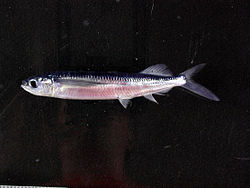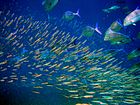Halfbeak
| Halfbeak Temporal range:
| |
|---|---|

| |
| Ballyhoo ( Hemiramphus brasiliensis ), a marine halfbeak
| |
| Scientific classification | |
| Domain: | Eukaryota |
| Kingdom: | Animalia |
| Phylum: | Chordata |
| Class: | Actinopterygii |
| Order: | Beloniformes |
| Superfamily: | Exocoetoidea |
| Family: | Hemiramphidae T. N. Gill , 1859
|
| Genera | |
|
see text | |
Hemiramphidae is a
Though not
.Taxonomy
In 1758,
There are currently eight genera within the family Hemirampphidae:[3]
- Arrhamphus Günther, 1866
- , 1882
- Gill, 1859
- Hemiramphus Cuvier, 1816
- Hyporhamphus Gill, 1859
- Melapedalion Fowler, 1934
- Oxyporhamphus Gill, 1864
- Rhynchorhamphus Fowler, 1928

This family is primarily
.Evolution
The halfbeaks'
Phylogeny
| ||||||||||||||||||||||||
Phylogeny of the halfbeaks.
|
The
On the one hand, there is little question that they are most closely related to three other families of streamlined, surface water fishes: the
On the other hand, recent studies have demonstrated that rather than forming a single
Within the subfamily Hemiramphinae, the "flying halfbeak" genus Oxyporhamphus has proved to be particularly problematic; while morphologically closer to the flyingfishes, molecular evidence places it with Hemiramphus and Euleptorhamphus. Together, these three genera form the sister group to the flyingfish family.[5] The other two hemiramphine genera Hyporhamphus and Arrhamphus form another clade of less clear placement.[5]
Rather than being closely related to the flyingfishes, the subfamily Zenarchopterinae appears to be the sister group of the
Morphology

The halfbeaks are elongate, streamlined fish adapted to living in open water. Halfbeaks can grow to over 40 centimeters (16 in) SL in the case of
As is typical for surface dwelling, open water fish, most species are silvery, darker above and lighter below, an example of countershading. The tip of the lower jaw is bright red or orange in most species.[1]
Halfbeaks carry several adaptations to feeding at the water surface. The eyes and nostrils are at the top of the head and the upper jaw is mobile, but not the lower jaw. Combined with their streamlined shape and the concentration of fins towards the back (similar to that of a pike), these adaptations allow halfbeaks to locate, catch, and swallow food items very effectively.[9]
Range and habitat

Halfbeaks inhabit warm seas, predominantly at the surface, in the
Ecology and behavior
Feeding
Marine halfbeaks are
Behavior
Marine halfbeaks are typically
Some marine halfbeaks, including Euleptorhamphus velox and Euleptorhamphus viridis, are known for their ability to jump out of the water and glide over the surface for considerable distances, and have consequently sometimes been called flying halfbeaks.[2][16][17]
Reproduction
Hemiramphidae species are all external fertilizers.[7] They are usually egg-layers and often produce relatively small numbers of fairly large eggs for fish of their size, typically in shallow coastal waters, such as the seagrass meadows of Florida Bay.[18] The eggs of Hemiramphus brasiliensis and H. balao are typically 1.5–2.5 mm (0.059–0.098 in) in diameter and have attaching filaments. They hatch when they grow to about 4.8–11 mm (0.19–0.43 in) in diameter.[1] Hyporhamphus melanochir eggs are slightly larger, around 2.9 mm (0.11 in) in diameter, and are unusually large when they hatch, being up to 8.5 mm (0.33 in) in size.[15]
Relatively little is known about the ecology of juvenile marine halfbeaks, though estuarine habitats seem to be favored by at least some species.[15][18] The southern sea garfish Hyporhamphus melanochir grows rapidly at first, attaining a length of up to 30 cm (12 in) in the first three years, after which point growth slows.[15] This species lives for a maximum age of about 9 years, at which point the fish reach up to 40 cm (16 in) and weigh about 0.35 kg (0.77 lb).[15]
Relationship to humans
Halfbeak fisheries
Halfbeaks are not a major target for
In some localities significant bait fisheries exist to supply sport fishermen.[1][11][12] One study of a bait fishery in Florida that targets Hemiramphus brasiliensis and Hemiramphus balao suggests that despite increases in the size of the fishery the population is stable and the annual catch is valued at around $500,000.[12][19]
See also
- USS Halfbeak (SS-352) American submarinenamed after these fish
References
- ^ a b c d e f g Collette, Bruce B. (February 2004). "Family Hemiramphidae Gill 1859 – Halfbeaks" (PDF). California Academy of Sciences Annotated Checklist of Fishes. Archived from the original (PDF) on 2006-06-23.
- ^ a b c d Froese, Rainer, and Daniel Pauly, eds. (2007). "Hemiramphidae" in FishBase. Aug 2007 version.
- ^ Eschmeyer, William N.; Fricke, Ron & van der Laan, Richard (eds.). "Genera in the family Hemiramphidae". Catalog of Fishes. California Academy of Sciences. Retrieved 18 August 2019.
- S2CID 89531400.
- ^ PMID 21676722.
- ^ ISBN 978-0-86542-256-8.
- ^ ISBN 978-0-471-25031-9.
- JSTOR 2992326.
- ISBN 978-0-8069-3722-9.
- NOAA, 2004). Studies in Tropical Oceanography. 5: 665–847. Retrieved 2009-06-22.
- ^ doi:10.1071/MF04305.
- ^ a b c Mahmoudi, B; McBride, R (2002). "A review of Florida's halfbeak bait fishery and halfbeak biology, and a preliminary stock assessment" (PDF). Florida Fish and Wildlife Conservation Commission. Archived from the original (PDF) on 2007-10-25. Retrieved 2009-06-22.
- ^ a b c d McGarvey, R.; Fowler, A. J.; Feenstra, J. E.; Jackson, W. B. (2006). "Garfish (Hyporhamphus melanochir) Fishery, Fishery Assessment Report to PIRSA for the Marine Scalefish Fishery Management Committee". SARDI Research Report Series. 163: 1–55.
- ^ a b c Stewart, John (2007). "An observer-based assessment of the estuarine fishery for eastern sea garfish (Hyporhamphus australis) in Australia". NSW Department of Primary Industries – Fisheries Final Report Series. 87: 1–14.
- ^ a b c d e f Lyle, J. M.; Jordan, A. R. (1988). "Tasmanian Scaleless Fisheries Assessment". Tasmanian Aquaculture and Fisheries Institute Fishery Assessment Reports. 1: 1–87.
- ^ Froese, Rainer; Pauly, Daniel (eds.) (2007). "Euleptorhamphus velox" in FishBase. Aug 2007 version.
- ^ Froese, Rainer; Pauly, Daniel (eds.) (2007). "Euleptorhamphus viridis" in FishBase. Aug 2007 version.
- ^ S2CID 26249413.
- ^ "Status and Trends of Florida's Halfbeak Fishery". Retrieved 2007-02-10.

